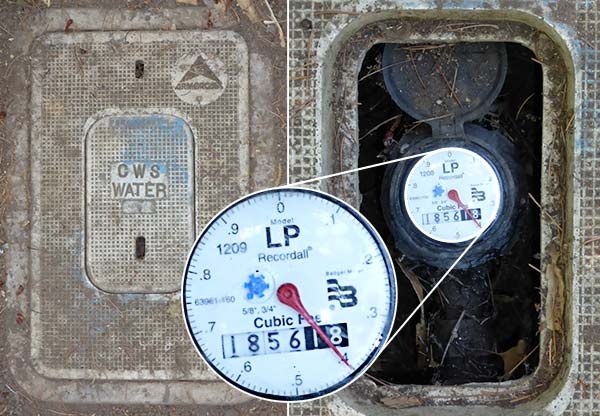By John Smith, Butte County Master Gardener, June 19, 2015

To check your water usage, first locate your meter. Bring a screwdriver, a flashlight, and pen and paper with you. Use the screwdriver (or similar lever-type tool) to wedge into the slot on the “lid” over the meter, and lift it off; then shine the flashlight inside to make sure no black widows or other dangerous creatures are lurking in there. You will probably have to brush some debris off the face of the meter. When you do, you will be looking at a large circular dial, a smaller blue dial, and, below them both, a series of numbers. Write those numbers down. This is the base you will begin with. Once you have those numbers, you can start to calculate your daily water consumption.
Each full number in front of the decimal point on that gauge represents one unit which is 1Ccf or 748 gallons of water. The numbers to the right of the decimal point are in 1/100s (one-one-hundreths) of 748. The larger dial moves clockwise, indicating water use up to 748 gallons; when that number is reached, the full number on the gauge increases by one. The smaller blue dial indicates that water is being used at that moment. If all of your water is shut off, the blue dial should not be moving. If it is, you have a water leak or water on somewhere on your property.
There are several ways to use this information to become a more informed water user and to reduce overall water consumption.
- If you note down the water gauge number late on a night when you are not irrigating, then check the gauge again in the morning, you should be able to tell if you have a water leak somewhere on your property. –If the gauge tells you that water has been used when you have not, to your knowledge, used any water, somehow water is leaking out.
- Test how much water you actually use when hand watering with a hose. It certainly seems like hand watering uses much less water than sprinklers – but does it really? Check the number on your water meter, then, using a stop watch, see how much water you actually use in one minute with the hose on full force. Or see how many seconds it takes to fill up a five-gallon bucket watering can.
- Check that water meter number, then take your usual shower, and check that number afterwards. Subtract the smaller number from the larger and multiply that decimal number times 748. Your answer will be the number of gallons used.
- If you have an automatic watering system, record your pre and post irrigation meter readings, then use procedure above to calculate gallons of water used each time your irrigation system runs.
Those living in the Paradise Irrigation District (PID) have access to a more advanced individual water-usage information system than those with Cal Water. The water meters of PID customers are green (easy to spot). A system known as "Aqua Hawk Alerting" reports water use every hour on the hour. This information is updated online every 24 hours. PID customers can log in online to view their previous day's water use. This system allows users to look at a daily water use graph which is helpful in evaluating the effect of their water-saving strategies. Aqua Hawk will notify customers by phone, text, or email if it detects a possible leak. This system also allows customers to specify an amount of water (in gallons) or an estimated bill amount (in dollars) that they don't want to exceed. If water consumption or bill amount exceeds or is projected to exceed the threshold value,AquaHawk will send a notification. This is very helpful in meeting water budgets.
Cal Water has not adopted this reporting technology, but by logging in their account number online, Cal Water customers can view graphs of their monthly water usage, comparing 2013 and 2014 usage with the newly-reduced monthly targets.
Lawn Removal Advice
By Eve Werner, Butte County Master Gardener
California Water Service is offering rebates for those in single-family residences who remove lawn and replace it with drought-tolerant plants. This is a great opportunity—it is not difficult to realize landscape water savings of over 80% through careful plant selection, site preparation, and accurate application of irrigation. .
However, the current rules for the rebate require that homeowners complete their lawn removal project within 120 days of gaining approval to start work. Please note that four months is not enough time to properly kill many Chico lawns, especially those which contain Bermuda grass. If the lawn replacement project is started during the summer, the time restriction on the rebate forces replanting during our hot season, which can result in the stress or death of the new plantings.
The optimum time to plant a dry garden is between November, when the first rains begin to fall, and February. Planting during that period gives plants a chance to establish roots before the summer heat arrives, and before the soil begins to dry out.
In the meantime, you can properly kill your lawn. Our next Real Dirt column will explain how to do just that.